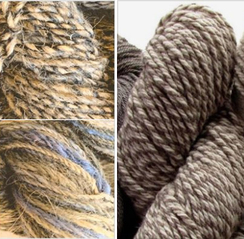Wednesday, April 3, 2019
TO DEHAIR OR NOT TO DEHAIR, NOT A BLACK AND WHITE SUBJECT.

TO DEHAIR OR NOT TO DEHAIR, NOT A BLACK AND WHITE SUBJECT.
Let’s talk dehairing. Let’s explore all sides of this process. There are many different trains of thought on dehairing. So I think it would be beneficial to hear from YOU on both sides and talk about, what people think, what people have experienced and why people think what they do.
Some questions I would like to explore are;
Does dehairing work on alpaca?
When is dehairing needed?
When is dehairing NOT needed?
What are some of the pros and cons of dehairing?
If you dehair, why?
If you do not dehair, why?
This is something that I have been very interested in for a long time. When I first entered the alpaca world, I took a course with the Certified Sorters. This was a training process that taught us to grade fiber in Grades 1-6, according to micron ranges, taking into account the presence of Primary and Secondary fibers. Fleeces with a lot of Primary fibers were deemed “Hairy” and went to the rug pile. Dehairing was not considered an option at the time because of Ian Watts Histogram work. I was always kind of uncomfortable with putting so many fairly nice blankets into the rug pile.
Recently I have taken a course through, Sorting, Classing, Grading (SCG). This is a collaboration of several experts in the field. This grading system DOES take into account dehairing as a value added option that brings value of fleeces that would otherwise be deemed “HAIRY” and sent to the rug pile. I like this train of thought because it brings value to many alpacas across the country that would otherwise produce lots and lots of rug yarn. And it makes alpaca fiber farming a more sustainable option.
This next part is what I have come to believe through my own study. This is my personal opinion, take or leave it but let’s talk.
My current belief on this matter is as follows. This is over simplified so please think in broad terms and bear with me. I did not want to write a novel.
1. Not all alpaca fleeces need to be dehaired. If your fleeces are uniform, dehairing may not be needed. Uniformity to me, means that the fibers across the blanket are relatively close in size. If your fleeces are grades 1 with stronger fibers being grade 2, you may not benefit from dehairing.
2. If you have a nice fleece that has strong primaries present, dehairing may be a good option for you. For example a Grade 3 fleece with a bunch of Grade 5 primaries. Dehairing can turn a lower quality fleece into something desirable. IMHO and from personal experience.
3. If your fleece has a bit too much veg in it. You may benefit from dehairing.
4. Dehairing can bring value to fleeces and alpacas that would otherwise have little value.
5. Dehairing strengthens the sustainability of alpaca in a natural fiber producing environment.
Your feedback and opinions are encouraged and appreciated.